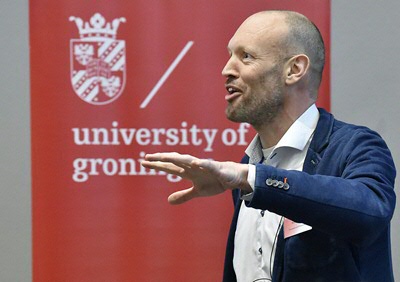Lecturer’s Blog 9: "Active learning @work" by Marc Kramer

Even before the Covid-pandemic, one of my larger challenges was a lack of student participation. A significant number of students did not attend, joined the classroom unprepared, or was inactive in class. Also in my online sessions similar patterns emerged. Probably, many of us have similar experiences. Although learning happens in many forms, the online teaching during the last two years made me realize even more that face-to-face encounters in a classroom are often crucial. I am therefore happy to see that we will remain primarily a campus-based university. Of course, we need to keep the many benefits of online approaches. In my view, precisely in such a blended approach active learning can be very effective.
What is active learning?
For me, the easiest way to understand is to start from the opposite. Passive learning essentially means that students listen and absorb while the lecturer talks. Although, I sincerely believe that it can be very valuable, inspiring and enjoyable to listen to a speaker who masters a certain discipline, it can only be a part of a course’s didactic portfolio. Active learning in contrast, refers to participation, discussion, working on a problem in a team, presenting, writing, etc.
To put students in an active learning mode, it may help if we nudge students a bit by using incentives and deadlines. I experienced myself that small rewards for desired behavior can be of great help. Although, many of our students are intrinsically motivated to learn, they tend to procrastinate (like many of us) which is detrimental for learning. Student really plan to study, prepare their homework, come to class, but in the end, they often don’t, often regretting it afterwards.
TEL-Tools
I experimented with various approaches to activate students. In one of my courses in which 150 students participate, I follow a blended approach. For example, I upload 3 to 5 video clips every week in the Interactive Video tool of Feedback Fruits. Every few minutes the video stops while a multiple-choice question appears. The video continues after answering the question. I prepare the video such, that the explanation of the correct answer follows right after students answered the question. At the end of every course week, I award credits for watching the entire video before the tutorial, and I give some additional credits for correct answers. For all approximately 25 video assignments combined, students earn 10% of the final course grade. I noted that all students that participated in the final exam also participated in almost all weekly video assignments. A similar pattern emerged when I use the TEL-tool Perusall in the same course. Students then read academic papers jointly online, while placing so-called annotations (additions, critical remarks or questions) within the paper. Fellow students and I may then respond. Again, to receive credits students needed to fulfill a few criteria before a weekly deadline. This combination of rewards, deadlines and receiving a score every week proved to motivate and activate students. The largest advantage I experienced was that almost all students in my course studied the course material on a regular basis, and those that joined the sessions came in better prepared, which made our classroom time much more effective.
Active Learning Classrooms.
Another experiment was the use of active learning classrooms. I was happy to participate in a pilot of such rooms in the Oude Boteringestaat 18. Now, at Zernike, we have our own ZEO-rooms (ZEO stands for the Dutch translation of Zernike Experimental Learning Classrooms) that you can schedule (note: the two connecting rooms in the Duisenberg building jointly accommodate approximately 100 students, so also larger courses may benefit).
The central idea of such active learning classrooms is that the room becomes part of the didactic approach. The room contains movable chairs and tables, multiple whiteboards and video screens. The layout of the room already provides a different mindset. In a standard room, the teacher typically stands in front of the class while students sit in rows and are directed to watch the blackboard in the front. On the contrary, in the active learning classroom, the lecturer can stand anywhere, and students typically sit in smaller groups at round tables, where each table has its own whiteboard and video screen. Students can easily use their own laptops to work on group assignments. The setting creates more room for active learning. You can invite students to stand up, and write their ideas on the white board while discussing them with team members, or walk around and listen to discussions in other groups. As a teacher, it is easy to walk around, listen and to ask questions. Already the fact that students stand up and walk around, creates a much more active and lively atmosphere.
What did students have to say?
Let me share a few comments from the student evaluations. On the TEL-tools FeedbackFruits and Perusall: “The use of Perusall to make annotations to important papers made the course dynamic and interesting”, “The set–up of smaller videos with multiple choice questions allowed for easy understanding”, “…the use of Perusall and FeedbackFruits helped us understand the topic every week, was more fun to do (compared to other courses) and made the course more challenging” and “I really liked the structure of the weeks in which we made annotations on the papers and then discussed them during the practicals”. And, on the use of the Active Learning Classrooms: “Very nice learning atmosphere”, “Engaging activities in class”, “Fun and helpful interactive activities” and “Very interactive, very engaging”.
In sum, active learning may assist in students learning better, fits well within a blended approach and is more fun for both students and lecturers.
I like to pass on writing this blog to Padma Rao Sahib, a very experienced and good lecturer in various research method courses in our BSc E&BE programme. I am looking forward to read her valuable insights.
